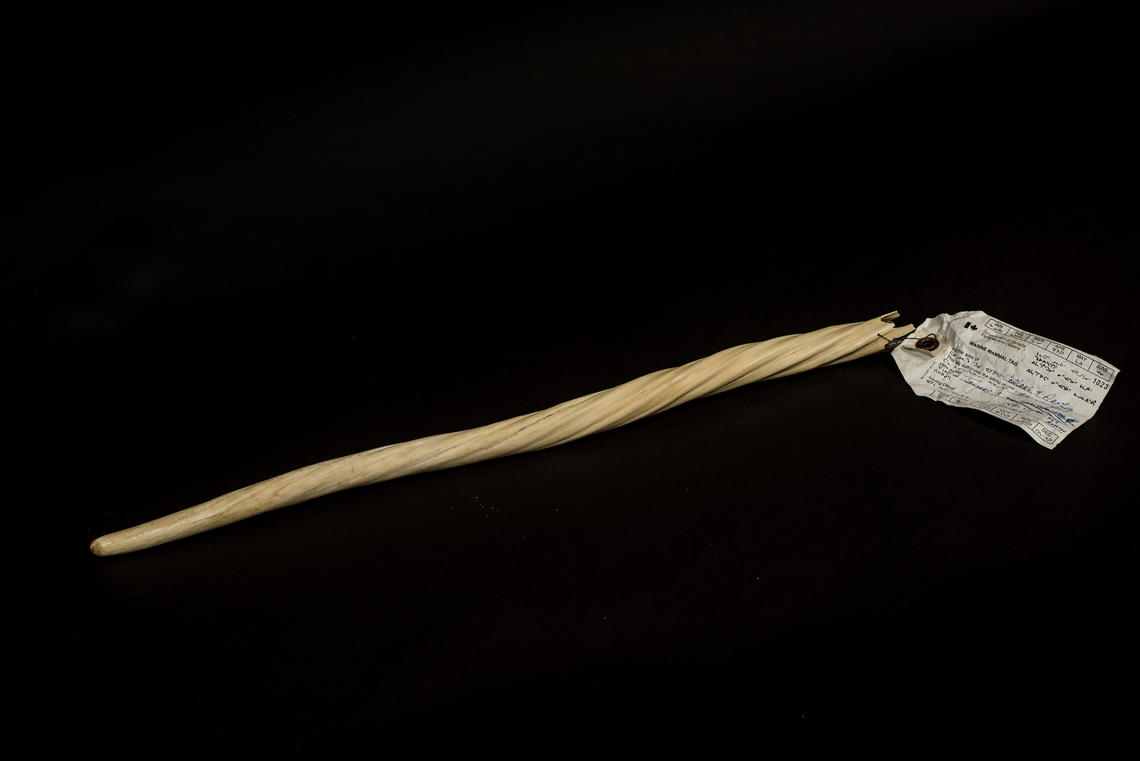Oct. 21, 2020
After surprising stop at Goodwill, rare narwhal tusk finds new home at UCalgary

A two-foot (61-centimetre)-long narwhal tusk has found a new home at UCalgary’s Arctic Institute of North America (AINA), after making a surprising stop at a Goodwill donation centre in Calgary. The tusk, complete with Canadian federal hunting tags from 1978, has been gifted to AINA by Goodwill Industries of Alberta to reside permanently in the AINA collection.
A narwhal tusk is a protruding, spiral canine tooth that can grow to 10 feet (3 metres) long and has up to 10 million nerve endings inside. Their exact purpose is unknown, but scientists believe the tusks are used for hunting or mating purposes.

This tusk, complete with Canadian federal hunting tags from 1978, has been gifted to AINA by Goodwill Industries of Alberta.
The mysterious mammals are a protected species, and the subsistence harvest and related sale of tusks is co-managed by the high Arctic communities and the governments of Nunavut and Canada. There are no narwhals in captivity, so tusks are the closest that most people will get to seeing a ‘unicorn of the sea’ in person.
“The tusk was collected by an Inuk while hunting, likely primarily for food,” says Dr. Sandie Black, DVM, clinical associate professor in the Faculty of Veterinary Medicine and head of veterinary services at the Calgary Zoo. “Narwhal maqtaq – skin and a small amount of blubber – is an important food energy source for many communities.”
Black believes the tusk is from a young narwhal, approximately three to five years of age. “The tusk represents an opportunity for cash income when sold,” she says. “Tusks are a platform for artistic expression in modern Inuit communities, and are carved by craftspeople in the community to be sold through art co-operatives or other outlets.”
The tusk was donated anonymously, like many unique objects that are given to Goodwill donation centres. While the intention of the donor is unknown, Goodwill wanted to give the tusk to an organization that would preserve its historical and cultural integrity.
“This is a way to create an educational opportunity in our community based on historical, environmental and cultural significance," says Dale Monaghan, CEO of Goodwill Industries of Alberta. "We are proud to work with the Arctic Institute of North America to feature higher learning of what the narwhal means to those living in the Arctic."
AINA maintains a large collection of Arctic art and artefacts, used in its educational, outreach, and online programming. “Our collection did not previously include a narwhal tusk and we are excited to receive this specimen from Goodwill,” says Shannon Christoffersen, manager of data and information services, AINA. “We look forward to including it in our educational exhibits and programming to help others learn more about the Canadian Arctic.”
“Narwhals are a Canadian treasure,” says Black. “They are a highly intelligent small whale species which only exists in the Arctic, and considerably more than half the existing number of animals are found in Canadian waters. In Canada, our collective actions in managing Arctic development sustainably, and in safeguarding the marine Arctic, will determine their future.”
A handoff of the narwhal tusk will take place in a closed celebration, as both organizations continue to practice safe measures during COVID-19.
The Arctic Institute of North America (AINA) is Canada’s first and longest-lived Arctic research institute. AINA was created by an Act of Parliament in 1945 as a nonprofit, tax-exempt research and educational organization, and has been a part of the University of Calgary since 1976.



